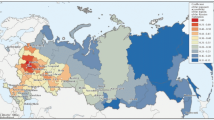Abstract
Regional accessibility is an important location factor, which enhance the region and, therefore, promote economic growth. It is the virtual aim of transport policy, on European as well as on national level, to strengthen regional accessibility. But available resources to do so are limited. Therefore, new investment and enlargement in transport infrastructure should be based on efficiency considerations. This article focuses on the economic impact of regional accessibility and in different economic sectors in order to prepare a methodology of planning for efficient transport infrastructure investment along the corridor Rotterdam-Genoa. The approach takes into consideration that the output of economic sectors depends differently on logistic services. If we consider different regional concentrations of specific sectorial activity, we can assume different economic impacts of transport infrastructure investment on different regions or, in other words, higher ‘costs of non-doing’ if bottlenecks in transport infrastructure persist. Therefore, the link between transport costs and regional accessibility in transport infrastructure is analyzed. The results of an empirical study which surveys the correlation between regional accessibility and regional sector output will be described.
Access this chapter
Tax calculation will be finalised at checkout
Purchases are for personal use only
Similar content being viewed by others
References
European Commission (2011) Roadmap to a single European transport area—towards a competitive and resource-efficient transport system. White paper on transport, Brussels
European Commission (2013) EU Cohesion policy contributing to employment and growth in Europe. Joint paper from the directorates-general for regional and urban policy and employment. Social Affairs and Inclusion, Brussels
Bundesministerium für Verkehr und digitale Mobilität (2013) Grundkonzeption für den Bundesverkehrswegeplan 2015. Bedarfsgerecht-transparent-herausfordernd. Report, Berlin
Abele G (2009) Transportwirtschaft. Einzelwirtschaftliche und Gesamtwirtschaftliche Grundlagen. Oldenbourg, München
Samuelson P (1948) Economics: an introductory analysis. McGraw-Hill, New York
Deutsche Bank Research (2003) Road operation projects: lucrative for institutional investors. Frankfurt voice, Frankfurt, 10 June
Press release Meldung “Bundesmittel stehen fest”. In: Eisenbahn-Revue international 5/2004, p 194
Bundesverband der deutschen Industrie et al (2012) Damit Deutschland wirtschaftlich stark bleibt. In die Verkehrsinfrastruktur investieren, die Grundlage des Wachstums sichern. Common Declaration, Berlin
Scholl B, Braun C, Ghünter F, Otsuka N, Tosoni I (2013) Code24—a common strategy for the corridor Rotterdam-Genoa. Report WP1, Zurich
Litman T (2010) Evaluating transportation economic development impacts. Victoria Transport Policy Institute, Victoria
Krugman P, Obstfeld M, Melitz M (2012) International economics. Pearson, Essex
Hummels D (2007) Transportation costs and international trade in the second era of globalization. J Econ Perspectives 21(3):131–154
Harrigan J, Venables A (2006) Timeliness and agglomeration. J Urban Econ 59(2):300–316
Nordås H, Pinali E, Geloso Grosso M (2006) Logistics and time as a trade barrier, OECD Trade Directorate. Working papers 35, Paris
Hummels D, Skiba A (2004) Ship** the good apples out: an empirical confirmation of the Alchian-Allen conjecture. J Polit Econ 112(6):1384–1402
Weber A (1909) Über den Standort der Industrie: Reine Theorie des Standorts. Mohr, Tübingen
Christaller W (1933) Die zentralen Orte in Süddeutschland. Gustav Fischer Verlag, Jena
Lösch A (1944) Die räumliche Ordnung der Wirtschaft, 2nd edn. Gustav Fischer Verlag, Jena
Biehl D (1991) The role of infrastructure in regional development. In: Vickerman RW (ed) Infrastructure and regional development. European research in regional science, vol 1. Pion Ltd, London, p 9–35
Blum U (1982) Effects of transportation investments on regional growth: a theoretical and empirical investigation. Pap Reg Sci Assoc 49:169–184
Wegener M, Bökemann D (1998) The SASI model: model structure. Deliverable D8 of the EU project socio-economic and spatial impacts of transport infrastructure investments and transport system improvements (SASI), Dortmund
Holzhey W (2010) Rail network 2025/2030, Expansion concept for an efficient rail freight service in Germany. Report for Umweltbundesamt (ed), Dessau-Rosslau
Rothengatter W (1996) Bottlenecks in European transport infrastructure. Paper presented on the European transport conference, Brunel University, Uxbridge, 01 Jan 1997
Cipolina S, Ghiara H (2011) Market situation and context analysis. Project report MoS24, Genoa
Drewello H, Günther F (2012) Bottlenecks in railway infrastructure—do they really exist? The Corridor Rotterdam-Genoa. Paper presented on the European transport conference, Crowne Plaza Hotel, Glasgow, 10 Aug 2012
Spiekermann K, Wegener M (2006) Accessibility and spatial development in Europe. Scienze Regionali 5(2):15–46
Stewart JQ (1947) Empirical mathematical rules concerning the distribution and equilibrium of population. Geogr Rev 37:461–485
Wegener M, Eskelinen H, Fürst F, Schürmann C, Spiekermann K (2001) Kriterien der räumlichen Differenzierung des EU-Territoriums: Geografische Lage—Studienprogramm zur Europäischen Raumplanung des Bundesministeriums für Verkehr-, Bau- und Wohnungswesen, Bonn
Meyer-Rühle O, Beige S, Bozuwa J, Burg R, Erhardt T, Harmsen J, Hua-Kellermann N, Greinus A, Kille C, Kok R, Röhling W, Roth M (2008) Statistical coverage and economic analysis of the logistics sector in the EU (SEALS). Final report prepared for the European Commission, Basel
Banister D, Berechman J (2000) Transport investment and economic development. University College London Press, London
CIA World Factbook (2013) Released at https://www.cia.gov/library/publications/the-world-factbook/, on 13/12/16
IMF World Economic Outlook Database, released at http://www.imf.org/external/pubs/ft/weo/2013/02/weodata/index.aspx, on 13/12/16
PTV (2009) VISUM—State-of-the-art travel demand modeling. Report Karlsruhe
Eichhorn C (2011) CODE 24 Transport odel—concept. Code24 report, Karlsruhe May 2011
Bleisch A (2005) Die Erreichbarkeit von Regionen: Ein Benchmarking-Modell, dissertation, Basel, released at http://edoc.unibas.ch/277/1/DissB_7206.pdf on 13/12/10
Drewello H, Weiß F (2014) Correlation analysis between regional accessibility and sector output for regions along the transport corridor Rotterdam-Genoa. 4th Code24 report of action 9, Kehl Feb 2014
Author information
Authors and Affiliations
Corresponding author
Editor information
Editors and Affiliations
Rights and permissions
Copyright information
© 2014 Springer International Publishing Switzerland
About this chapter
Cite this chapter
Drewello, H. (2014). Transport Policy and Regional Development: The Economic Impact of Regional Accessibility on Economic Sectors. In: Lami, I. (eds) Analytical Decision-Making Methods for Evaluating Sustainable Transport in European Corridors. SxI - Springer for Innovation / SxI - Springer per l'Innovazione, vol 11. Springer, Cham. https://doi.org/10.1007/978-3-319-04786-7_7
Download citation
DOI: https://doi.org/10.1007/978-3-319-04786-7_7
Published:
Publisher Name: Springer, Cham
Print ISBN: 978-3-319-04785-0
Online ISBN: 978-3-319-04786-7
eBook Packages: Mathematics and StatisticsMathematics and Statistics (R0)




